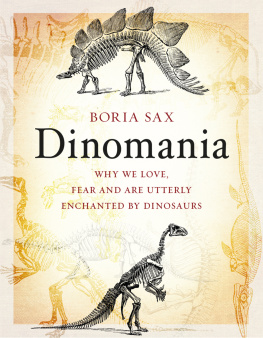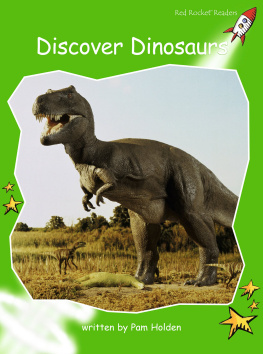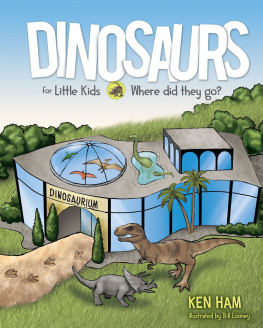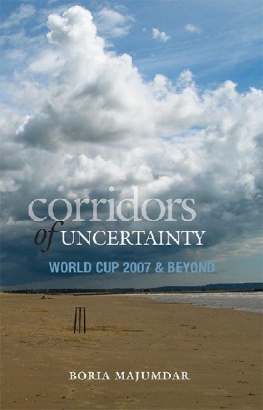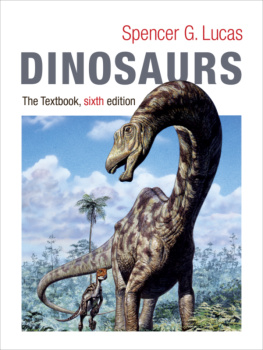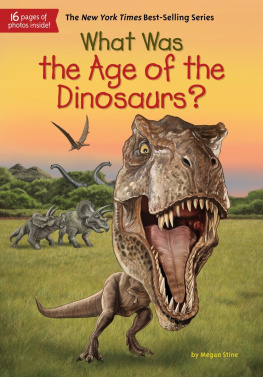No part of this publication may be reproduced, stored in a retrieval system or transmitted, in any form or by any means, electronic, mechanical, photocopying, recording or otherwise, without the prior permission of the publishers
Matthus Merian, engraving of a dragon, 1718. Like many dragons of the early modern period and earlier, this one shows a noteworthy resemblance to a dinosaur, especially with its extended neck and tail.
CHAPTER I
Dragon Bones
In your secret heart of hearts you wanted brontosaurus, tame of course, to come back in the world.
RAY BRADBURY, Dinosaur Tales
P eople have always known of dinosaurs, though they have called them by many names. Old legends that place Western dragons in caves or beneath the earth may have originated with fossils. The plumed serpent, prominent in mythologies of Mexico and Latin America, is often a creator of life. The Rainbow Serpent of Aboriginal tales was present at the beginning of time, and helped prepare the landscapes for human beings and other animals. The Asian dragon, which combines features of many animals, symbolizes primordial energy and is the bringer of rain. These figures resemble our reconstructions of dinosaurs in appearance, and accounts place them in worlds that existed before humankind. The major reason for this similarity might be that human imagination works in much the same way as evolution. Both constantly recycle familiar forms such as wings, claws, crests, fangs and scales, which may repeatedly vanish and then reappear through convergence. The figure of Tyrannosaurus rex suggests a kangaroo, while pterosaurs resemble bats, but the similarities are not due to common ancestry.
Children, who are just learning the basic expectations of their society, are in ways outside of culture. Their attraction to dinosaurs suggests that the giant creatures appeal to something innate, or at least very elemental, in the human psyche. One highly speculative explanation is that this is a genetic legacy, going back to the days when early humans faced gigantic, prehistoric lizards such as the megalania or perhaps even the days when our remote mammalian ancestors had to contend with dinosaurs themselves. A simpler explanation is that images of dinosaurs convey the excitement of danger while posing no actual threat. It could also be that dinosaurs, from a childs point of view, seem like grown-ups, since they are both very old and very big.
By inspiring fantasy, dinosaurs alleviate a childs feelings of helplessness. Gail Melson has described this vividly:
A slight, shy, eight-year-old boy I know hurries home after school each day to go back to the age when dinosaurs roamed the Earth. A walking encyclopedia of dinosaur lore, he never tires of playing out battles between brontosaurus and tyrannosaurus, using his six-inch high replicas. Unlike the power of adults or bigger, more assertive peers, dinosaur power is, literally, under his thumb.
And why do most children leave that fascination behind well before reaching adulthood?
Adults often feel almost as powerless as children. They find relief in such activities as blasting aliens in video games, as well as other pastimes that are far less innocuous, but seldom in playing with dinosaurs. But maybe grown-ups dont really get over the dinosaur phase? It could be that they simply relive it vicariously through children. We have traditionally thought of dinosaurs as tragic, since (with the exception, we now know, of avians) they became extinct, yet were once enormously large and powerful. This corresponds to thecombination of ability to dominate and extreme vulnerability, which are both essential aspects of the way we think of humankind.

Carvings from Ta Prohm temple in Cambodia, built in 1186. The figure looks uncannily like a stegosaurus. This might be due in part to a discovery of dinosaur bones, but it is probably simply a coincidence.
At any rate, that little boy is very far from being alone. At the American Museum of Natural History in New York, which I visit regularly, there is a shop in which almost an entire floor, one-third of the space, is devoted to dinosaur paraphernalia, and most of the items there have no more than a very oblique connection with science. There are shelves upon shelves of plush dinosaur toys, many of which are enormous. There are many picture books about dinosaurs, for children that are just learning to read, mechanical dinosaurs and countless accessories sporting pictures of dinosaurs.
That eight-year-old described by Melson could, in many ways, have been me, though palaeontology was not nearly so heavily commercialized in my childhood as it is today. Dinosaurs were, like presidents and teachers, accorded a lot of dignity. But in Chicagos Field Museum the reconstructed skeleton of an apatosaurus stood beneath the dome of a great hall. A huge bone was placed on a small pedestal in front of the skeleton, which people were invited to touch. When I did so, the bone seemed very hard and cold, almost metallic, but that only accented the metabolic warmth of the creature it had once helped to support. I was always a bit of a loner, as well as a romantic. Looking back, I suppose the world of dinosaurs was a sort of refuge for me, mostly from adults who thought they understood me yet never could.

Neolithic petroglyph in granite, dating from about 5,0006,000 BCE, showing a creature that has an uncanny resemblance to a sauropod dinosaur. Lake Onega, Republic of Karelia.
There is something comforting for people of all ages about the way at least some kids in every generation go through a dinosaur phase,despite all the changes that society has experienced in the last century and a half. Dinosaurs appeal to a Victorian sort of childhood wonder, as well as reassuring us that our childhood experiences are part of an eternal condition. The phenomenon is especially remarkable because it so often seems to first emerge spontaneously in children, with very little adult encouragement. Yet perhaps dinosaurs, after all, are no more immortal than human beings. The ways we imagine them, at least, have been subject to constant change since their initial discovery in the early nineteenth century.

